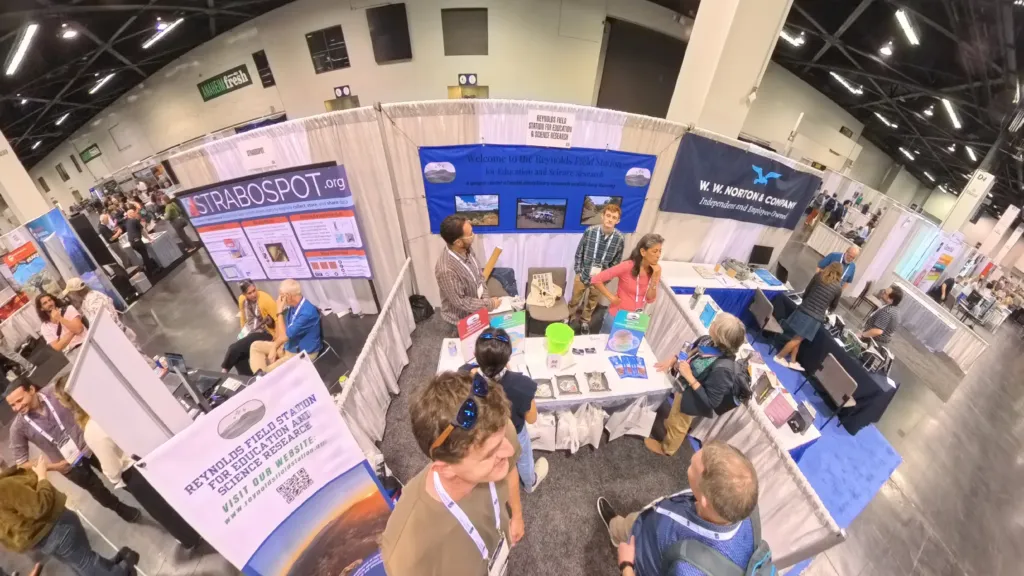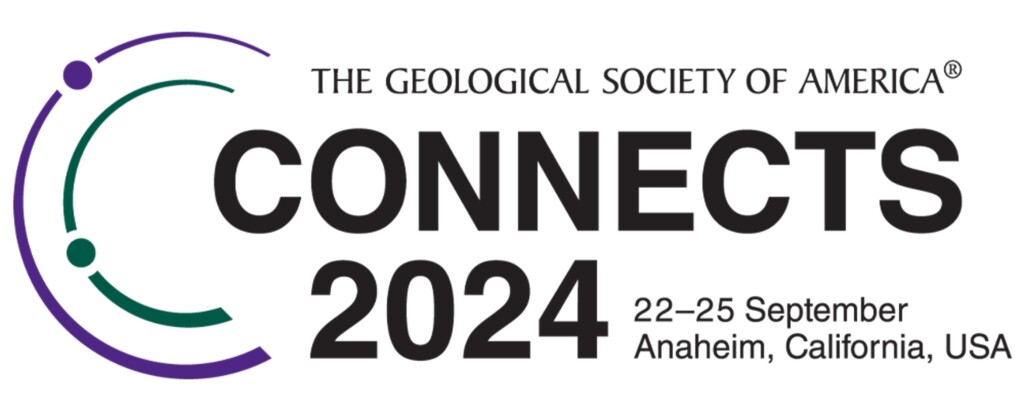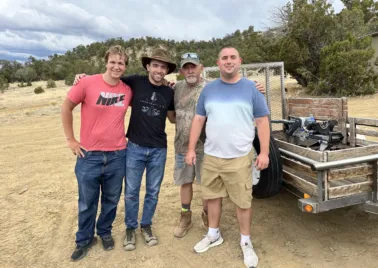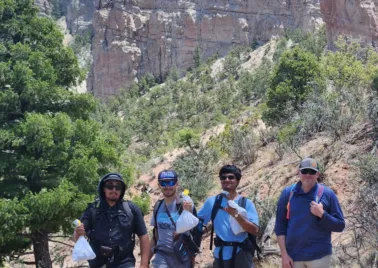
Reynolds Field Station Booth at Geological Society of America Connects 2025 Conference October 19-22, 2025 San Antonio, TX
RFS is pleased to announce the Reynolds Field Station booth at Geological…
September 22-25, 2024 Anaheim, CA

The Reynolds Field Station (RFS) exhibited at the Geological Society of America Connects 2024 Conference, giving visitors opportunities to talk to RFS Directors, pick up literature, and explore opportunities to visit and participate in Field Station learning and research programs. Students and faculty conducting research at the Field Station dropped by to give their first-hand views of the facilities.

We are proud to announce that several New Mexico State University graduate students presented poster sessions at GSA Connects 2024, all of whom have come out to RFS and several of whom are actively working on RFS Programs. You can check out their posters on our research page.
Leo Kuhl presented his field research and analysis for the RFS Program New Mexico State University Mapping and Geochronology of Crevasse Canyon Formation (NMSU002) in support of his Masters Thesis. His Poster Session was titled 30-4 – STRATIGRAPHIC HISTORY AND PROVENANCE OF THE LOWER PART OF THE CONIACIAN-SANTONIAN CREVASSE CANYON FORMATION IN WEST-CENTRAL NEW MEXICO. Update: Leo Kuhl successfully defended his Masters Thesis on October 13, 2025! See Leo’s thesis defense slides here.
Leo is the Primary Author, his co-authors are Brian Hampton, New Mexico State University and Dori Contreras, Perot Museum of Nature and Science. Here is Leo’s Abstract:
The Crevasse Canyon Formation in west-central New Mexico (at the Reynolds Field Station located north of the Sawtooth Mountains) outcrops along the southeasternmost margin of the Colorado Plateau and is thought to record fluvial-deltaic sedimentation along the Seboyeta embayment during the Late Cretaceous (Coniacian-Santonian time). Although this stratigraphic interval has received a considerable amount of study throughout parts of northwestern New Mexico and the Southwestern U.S., very little is known about the depositional history provenance of these strata in west-central New Mexico. Throughout much of the New Mexico, the Crevasse Canyon Formation has been documented to represent nonmarine, fluvial sedimentation and marks the stratigraphic transition from marine sedimentation to nonmarine sedimentation in the Cordilleran foreland basin.
New measured stratigraphic sections, paleocurrent indicators, modal composition trends, and U-Pb detrital zircon data from the lower parts of the Crevasse Canyon reveal a depositional system characterized by (1) isolated, cross-stratified channel sands encased in floodplain strata that contains fossilized leaves, stumps, woody debris, and charcolithified organic material, and (2) laterally extensive sandstone bodies that appear largely massive with isolated, faint cross stratification. Paleocurrent indicators from sandstone units display a wide range of flow directions that include northeast, east, and southeast directed paleoflow. Sandstone modes from these strata reveal high relative abundances of quartz (primarily monocrystalline), feldspar (plagioclase and K-Spar), and a range of lithic fragments dominated by volcanic and metamorphic lithic clasts. Detrital zircon results are compared here with previous work on the Crevasse Canyon from parts of southern New Mexico where the unit contains (1) Precambrian zircons that overlap with the Yavapai, Mazatzal, and Granite-Rhyolite, and Grenville provinces, (2) recycled Neoproterozoic and Early Paleozoic detritus from Mesozoic eolianites of the southwestern U.S., (3) Permian to Triassic zircons that overall in age with granitoid rocks in parts of California and Arizona, and Jurassic-Cretaceous detritus that overlaps with the mid-Mesozoic Cordilleran magmatic arc and Sierra Nevada batholith.
Geological Society of America Abstracts with Programs. Vol. 56, No. 5, 2024
doi: 10.1130/abs/2024AM-401522© Copyright 2024 The Geological Society of America (GSA), all rights reserved.
Thomas Valenzuela, a key contributor to RFS Program New Mexico State University Geology Field Camp Curriculum Development (NMSU001) presented a poster session in support of his Masters Thesis research in the San Juan Basin. His Poster Session was titled 116-13 – COMPOSITIONAL TRENDS AND PROVENANCE FROM EOCENE SYNOROGENIC STRATA OF THE SAN JOSE FORMATION, EAST-CENTRAL SAN JUAN BASIN, NORTHWESTERN NEW MEXICO. Update: Thomas Valenzuela successfully defended his Masters Thesis in Spring of 2025 and was awarded his MS Degree!
Thomas is the Primary Author, his co-authors are Nicole Salladin and Brian Hampton, both from New Mexico State University, and Kevin Hobbs, New Mexico Institute of Mining and Technology. Here is Thomas’s Abstract:
Although there has been extensive prior work on Jurassic-Paleocene strata in the San Juan Basin of northwest New Mexico, very little is known about the youngest, early-Eocene strata of the San Jose Formation. Presented here are new sedimentological and stratigraphic data (e.g., measured stratigraphic sections and facies analysis) as well as provenance data (e.g., U-Pb detrital zircon geochronology, sandstone modal composition, clast counts, and paleocurrent trends) from four previously identified members of the San Jose Formations. Also included for comparison are similar new data from the directly underlying early-middle-Paleocene Nacimiento Formation.
The Cuba Mesa member of the San Jose, making up the basal portion of the formation and unconformably overlying the Nacimiento, contained primarily lenticular, amalgamated, and stratified channel sand bodies, with isolated floodplain silts. The Regina member contained extensive floodplain silt and mud deposits with isolated cross-stratified channel sand bodies, not exceeding 15m in thickness. Compositional trends in samples of the Cuba Mesa and Regina members have dominant occurrences of quartz (Q), with minor Feldspars (F) and lithic fragments (L) (Q=67%, F=26%, L=7%). Detrital zircon ages from the lower 2 members of the San Jose had significant peaks at 1700 and 1450 Ma with minor peaks at 150 and 200 Ma. Mazatzal and A-type granite age signatures suggest source input from local basement cored uplifts, with minor input from Cordilleran Arc sources.
The Llaves member (overlying the Regina) contained extensive amalgamated cross-stratified channel sand bodies, ranging in coarseness from medium sand to granular, and had bodies of silty floodplain deposits. The Tapacitos member (overlying the Llaves) contained small amalgamated and cross-stratified channel sand bodies, with extensive silt-mud floodplains. Compositional trends of the Tapacitos and Llaves members have dominant occurrences of quartz, with very minor occurrences of feldspars and lithics (Q=85%, F=9%, L=6%). Detrital zircon ages from the upper two units saw peaks at 1700 and 1450 Ma, with minor age peaks at 1100 and 300-500 Ma. Llaves and Tapacitos members show continued basement cored uplift source areas with a reduction in inputs from Cordilleran Arc and an increased input of recycled Mesozoic Eolianites.
Geological Society of America Abstracts with Programs. Vol. 56, No. 5, 2024
doi: 10.1130/abs/2024AM-403725© Copyright 2024 The Geological Society of America (GSA), all rights reserved.
Nicole Salladin, a New Mexico State University graduate student, who assisted Leo Kuhl with his stratigraphic section mapping at RFS in 2023 presented a GSA Poster Session unrelated to RFS. Her Poster Session supported her Masters Thesis in the San Juan Basin. Her Poster Session is titled 277-7 – NEW Ar40/Ar39 DETRITAL SANIDINE GEOCHRONOLOGY FROM THE EOCENE SAN JOSE FORMATION, EASTERN SAN JUAN BASIN, NORTHWESTERN NEW MEXICO. Update: Nicole Saladin successfully defended her Masters Thesis in Summer of 2025, and was awarded her MS degree.
Nicole is the Primary Author, her co-authors are Thomas Valenzuela and Brian Hampton both from New Mexico State University, Kevin Hobbs and Matthew T Heizler both from New Mexico Institute of Mining and Technology, and Julia Ricci from New Mexico Geochronology Research Laboratory. Here is Nicole’s Abstract:
The San Juan basin (SJB) in NW New Mexico has been extensively studied to determine the timing of Laramide deformation, provenance, and sediment dispersal trends from Jurassic-to earliest Paleogene strata. However, little is known about the sources and mechanisms driving deformation and erosion during the deposition of the Eocene synorogenic strata of the San Jose Formation. The San Jose Formation comprises four units: (1) the basal Cuba Mesa Member (sand- and gravel-dominated), (2) the silt-dominated Regina Member, (3) the sand-dominated Llaves Member, and (4) the sand- and silt-dominated Tapicitos Member. Here, we present new 40Ar/39Ar detrital sanidine data from N=8 samples of the San Jose Formation.
The Cuba Mesa Member shows detrital sanidine peaks from 180-160 Ma and 80-63 Ma, with primary peaks at 74 Ma and a secondary peak at 81 Ma; the youngest grain is 61 Ma. The Regina Member exhibits peak ages between 180-220 Ma, 78-82 Ma, and 74-76 Ma, with the youngest grain at 65 Ma. The Llaves Member peaks between 260-280 Ma, with the youngest grain at 130 Ma. The Tapicitos Member peaks between 380-480 Ma, with the youngest grain at 360 Ma. Both Llaves and Tapicitos show a lack of late Mesozoic grains present in the lower members. Additionally, all members contain ages between 500-1000 Ma, with the youngest grain at 61 Ma in the Cuba Mesa Member.
Detrital sanidine ages older than 300 Ma likely represent other K-feldspar varieties such as microcline and orthoclase. Ages between 300-150 Ma overlap with the Sevier fold-and-thrust belt, while ages between 150-90 Ma overlap with the Cordilleran arc. Ages younger than 90 Ma likely derive from the Cordilleran arc and Laramide volcanism. The absence of grains from syn-depositional Eocene sources could be due to: (1) unfavorable paleoriver and climate patterns for sanidine deposition; (2) insufficient sample size due to low amounts of sanidine in the basin; (3) overwhelming presence of basement K-feldspars; or (4) a combination thereof. Younger grains are also less common in upper members, suggesting regional sources in the Cuba Mesa and Regina Members (Cordilleran arc, Sevier fold-and-thrust belt) and local sources in the Llaves and Tapicitos Members (microclines and orthoclases from nearby basement Laramide uplifts). These data support a model where the Llaves and Tapicitos Members were increasingly sourced from local Laramide uplifts.
Geological Society of America Abstracts with Programs. Vol. 56, No. 5, 2024
doi: 10.1130/abs/2024AM-402430© Copyright 2024 The Geological Society of America (GSA), all rights reserved
Emma Schantz, a New Mexico State University graduate student, who visited RFS with the Tectonics and Basin Analysis Class in Fall 2023 presented a GSA Talk unrelated to RFS. Her Talk supported her Masters Thesis in the Love Ranch Basin. Her Talk was titled 71-9 – DATING DINOSAURS IN THE LARAMIDE FORELAND: U-Pb GEOCHRONOLOGIC CONSTRAINTS ON A STRATIGRAPHIC SECTION CONTAINING ALAMOSAURUS AND THE POSTULATED TYRANNOSAURUS MCRAEENSIS IN THE LOVE RANCH BASIN, NEW MEXICO. Update: Emma Schantz successfully defended her thesis in 2025 and was awarded her MS degree.
Emma is the Primary Author, her co-authors are Jeffrey Amato, New Mexico State University and Timothy Lawton, University of Texas at Austin. Here is Emma’s Abstract:
An important dinosaur-bearing interval of fluvial strata occurs in the Upper Cretaceous McRae Group of the Laramide Love Ranch Basin in south-central New Mexico. The group in ascending order consists of the Jose Creek Fm., Hall Lake Fm., and Double Canyon Fm. Dinosaur fossils, including Alamosaurus and a potentially new species of Tyrannosaurus (T. mcraeensis; older than T. rex: Dalman et al., 2024), have been found in the HLF. We used LAICPMS to obtain U-Pb ages from detrital and igneous zircons from sandstone and tuffs of the McRae Group below, at, and above the tyrannosaurid locality. Herein we report new 238U/206Pb zircon dates (±2s) to establish the age of the strata containing the fossils, evaluate duration of Laramide deformation, and determine whether the K-Pg boundary is preserved in this section. Sandstones have abundant volcanic lithic grains and yielded many young detrital zircons interpreted to be approximately syndepositional. We used weighted means of the youngest grain clusters for max depositional ages (MDA).
The Hall Lake Fm. (HLF), ~700 m thick, consists of mudstone and sandstone; a tuff ~15 m above the unit’s base yielded an age of 73.6 ± 0.5 Ma. Strata 30 m above the base, in a different measured section that may be separated from the other section by a fault or unconformity, contained the postulated new Tyrannosaur, and a volcaniclastic sandstone at this fossil locality yielded an MDA of 69.0 ± 0.4 Ma (n=29, MSWD=1.0). A sandstone 2 m above this locality has an MDA of 69.5 ± 0.7 Ma. An Alamosaurus fossil occurs ~90 m above the base of the HLF, where zircons from a sandstone give an MDA of 69.5 ± 0.5 Ma. A sandstone ~550 m above the base of the HLF and ~150 m below the Double Canyon Fm. has an MDA of 63.2 ± 1.0 Ma, showing that the K-Pg boundary lies in the HLF, though strata at the boundary may not be exposed.
Sandstone at the base of the Double Canyon Fm. (DCF) yielded only two young zircons which have a mean of 61.5 Ma. Two tuffs ~80 m above the base of the DCF each yielded a mean age of 60.6 ± 1.2 Ma. Two sandstones higher in the DCF yielded MDAs of 57.6 Ma and 56.0 Ma, indicating that this formation spans the Paleocene and that the Love Ranch basin accommodated deposition well into Paleogene time.
Currently we infer that the key stratigraphic layer of T. mcraeensis is younger than 69.0 ± 0.4 Ma and older than the accepted K-Pg boundary age of 66.0 Ma.
Geological Society of America Abstracts with Programs. Vol. 56, No. 5, 2024
doi: 10.1130/abs/2024AM-405342© Copyright 2024 The Geological Society of America (GSA), all rights reserved.

RFS is pleased to announce the Reynolds Field Station booth at Geological…

RFS hosted three young professionals who went to high school together, but…

The Reynold’s Field Station (RFS) hosted its first official geology field camp…

INTERESTED IN LEARNING MORE?
We are passionate about the sharing the amazing environment and scientific learning opportunities at the Reynolds Field Station. We encourage you to Contact Us about ways you and your institution can participate in exploring and contributing to the science and appreciation of this natural wonderland. We are a 501(c)(3) public charity and welcome donations that will enable travel expenses, grants and scientific equipment for learners who need assistance participating at the Field Station.